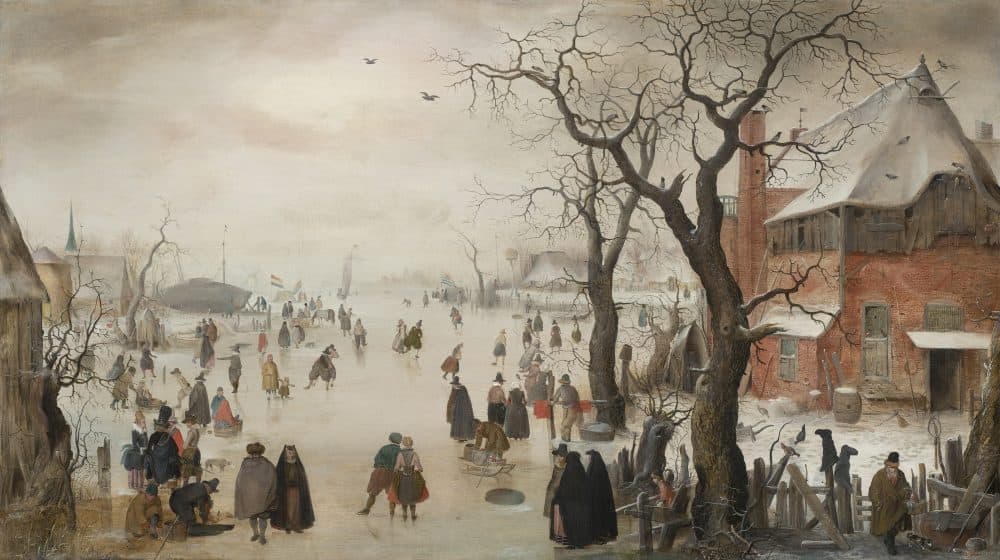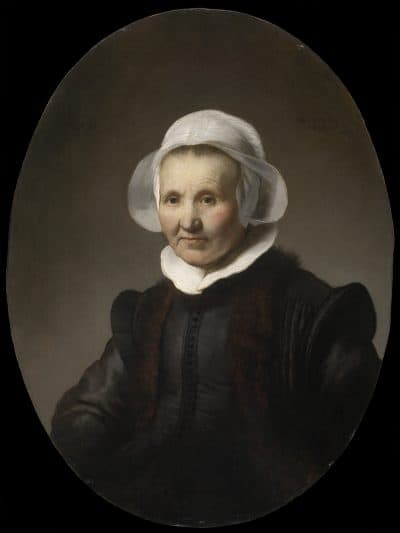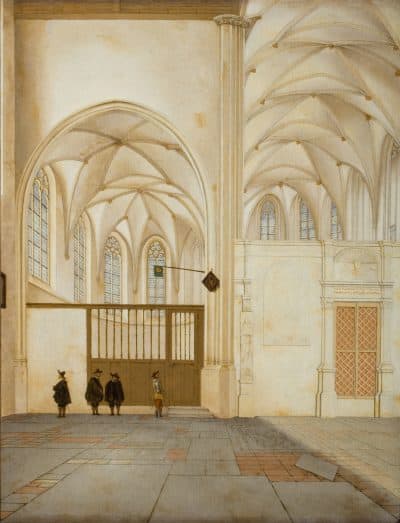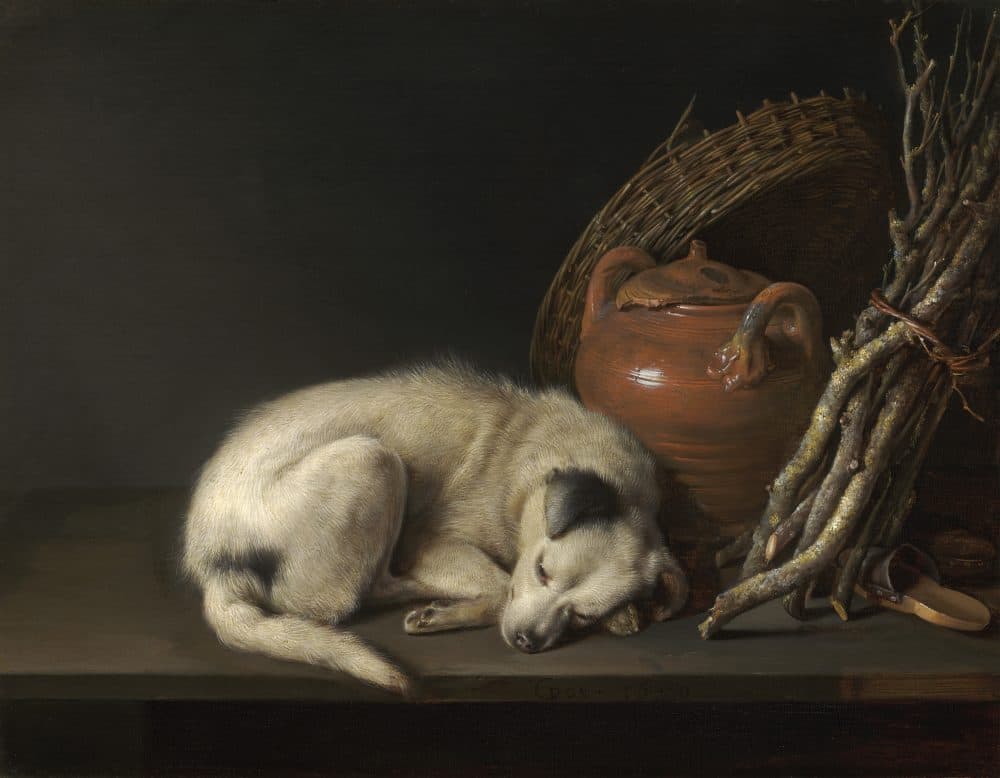Advertisement
MFA Doubles Collection Of 17th Century Dutch And Flemish Paintings With Major Gift

A still life of a dog at rest, a Dutch flagship navigating rough waters, locals skating through the barren trees in a wintry village. Paintings of these scenes are part of two top-notch troves of 17th century Dutch and Flemish paintings local collectors are giving to Boston's Museum of Fine Arts.
The two collections include 113 works by 76 artists, the MFA announced Wednesday. Taken together, the gifts will be the largest donation of European paintings in the nearly 150-year-old institution's history and nearly doubles the museum's holding of Dutch and Flemish paintings.
MFA director Matthew Teitelbaum said the lovingly amassed and maintained collections will help the museum tell new stories “of a moment in the history of art when art begins to be created for and shared with the masses, the people of the middle class."

Boston-area collectors Rose-Marie and Eijk van Otterloo and Susan and Matthew Weatherbie began collecting Netherlandish work in the '80s. The collection includes work by Rembrandt, Gerrit Dou and Peter Paul Rubens. Among the paintings are vibrant still lifes, rich land and seascapes and intimate portraits, including Rembrandt's “Portrait of Aeltje Uylenburgh, aged 62” from 1632.
Rose-Marie van Otterloo said Peter Sutton, a former curator of European art at the MFA, encouraged her and her husband to focus on collecting this genre.
She remembered Sutton asking them why they were collecting horse carriages and British sporting paintings and watercolors. "He made us understand that since we both spoke the Dutch language, and our heritage was Dutch and Flemish, it would be natural to collect Old Masters."
He took the couple to auction houses and introduced them to dealers. “And then it didn't take long to buy our first painting — a Jan van Goyen — which we still own today,” Rose-Marie van Otterloo said. Works from the collection the couple is giving to the MFA have been shown at the Peabody Essex Museum and the Yale University Art Gallery.
Teitelbaum, who became the museum's director in 2015, said conversations with the two couples have focused on “what could these collections together do that one alone couldn't to create focus and legacy — not for the collectors -- but for the art itself."
The gift will cement the van Otterloos' and Weatherbies' decades-long relationship with the MFA.
“Our wish is that the MFA will deal with our paintings the same way we have,” Rose-Marie van Otterloo said. “That means we want them to lend to other institutions, care for them the way we have and use them as a teaching tool for curators, conservators and all students studying art history or are interested in art.”
As part of the deal the MFA will also create the Center for Netherlandish Art, which has long been a dream for the van Otterloos. This includes their donation of the Egbert Begemann Library, which will allow students, scholars, curators and conservators to dig into material from what's known as the Golden Age in the Netherlands.
Susan and Matthew Weatherbie share similar visions for the paintings that have meant so much to them.
“We have confidence the MFA will care for, preserve and share these works of art with an ever-growing audience through generous loans to teaching museums who share our vision for enhancing object-based learning,” Susan Weatherbie said.
Part of Teitelbaum's mission for the MFA has been to diversify its holdings — notably acquiring New England's first Frida Kahlo painting — and to bring in younger audiences.

Some might think European masters could be a tough sell to the next generation, but "I don't buy it," Weatherbie said. "Many of these images sing with a contemporary flavor — everyday people at their everyday duties; glorious seascapes, winter scenes, landscapes celebrating nature.”
The Weatherbies hope the Center for Netherlandish Art will “break down these barriers and bring to life the universality of this art.”
As for their reasons for partnering with the MFA, Weatherbie explained, “For us, the MFA was the natural recipient for these works of art. It is a world class museum with an encyclopedic collection.”
Like the van Otterloos, the Weatherbies have been part of the MFA community for a long time. Former curator Peter Sutton also supported their blossoming interest in the beginning.
Both collecting couples have contributed their paintings to past exhibitions at the museum, have been members of the Board of Trustees and are major benefactors.
As you can imagine, for a longtime curator of European paintings like the MFA's Ronni Baer, these gifts are like a fantasy come true.
“The fact that two of the most important collectors in the world of this material have decided to put their trust in the MFA to take care of their collection — to exhibit the paintings, to interpret them, to research them and to train the next generation — is what a curator dreams of,” Baer said.
The curator spoke specifically about the exceptional condition of Rembrandt's “Portrait of Aeltje Uylenburgh, 1632,” saying, “it is among the most important paintings by Rembrandt in private hands. In our collection it actually helps us complete the story of when Rembrandt was working as a young artist.”
The portrait teaches the artist's technique, in part because the panel is pristine. “We see how he uses the brown ground to create warmth in her black costume,” Baer described, “we see him flicking his brush at her shoulder so the fur of her collar stands up against the dark background. It's just a virtuoso display of brushwork.”
Baer said she's been working with Boston-area collectors of Netherlandish paintings since she arrived at the MFA in 2000. “I've been doing exhibitions of Dutch art — all with that hope a gift of this magnitude could possibly happen. But I think curators always in live in hope, and hope is fed by the amazing generosity of these people who really understand the mission of the museum and who are completely committed to seeing the study of Dutch and Flemish art continue because there are not that many people teaching the field in America today.”
The curator is especially gratified to be able to work with the Gerrit Dou painting, “Dog at Rest, 1650,” that will be joining her at the MFA. Turns out Baer wrote her dissertation on the artist.

The van Otterloo and Weatherbie collections will come to the MFA at a later date, but an installation including a few works from the donors will open to the public Wednesday, Oct. 11 at 5 p.m.
